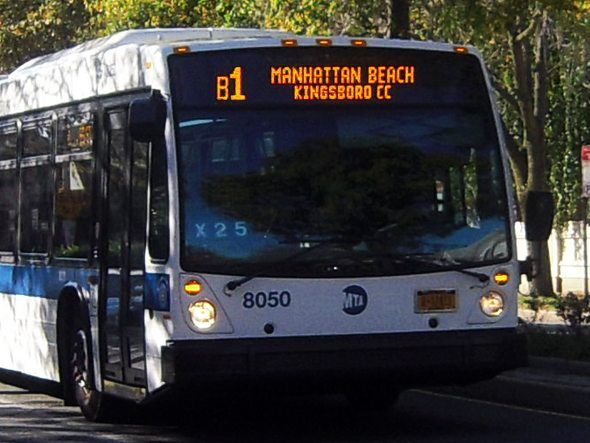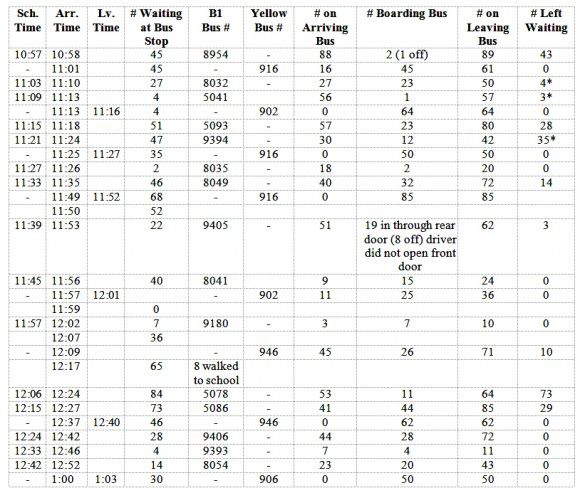B1 Update And Survey Results

THE COMMUTE: It’s been a while since I reported on the B1 bus. Last year I asked if the MTA was providing a private bus service for Kingsborough Community College. (Those problems still exist.) I made recommendations on how the college could assist the MTA to provide better service; and wrote how service could be reallocated by reducing it when too much service is provided on Friday afternoons. I reported about beach service. I even wrote about improvements I made while working for the MTA.
Summer Update
Last summer I promised to follow up on any additional weekend problems after Memorial Day. Luckily we experienced only one very hot summer weekend with temperatures over 100 degrees and there were no afternoon thunderstorms to cause a mass exodus from the beach. The excessively hot weather actually kept people away from the beach that weekend. The buses did not experience any unusual problems and the MTA kept their promise of posting a dispatcher at Mackenzie Street, at least at the beginning of the summer. It is not known if he was there throughout the summer, but in the end it really didn’t matter.
Brighton Station
A few months ago I noticed that there seemed to be a problem at the Brighton Beach station during the middays when I noticed about 100 students waiting for the B1. I know there are problems around 8:00 or 9:00 a.m., which I might look into further one day, but I never expected that the crowds lasted past 11:00 a.m. I decided to do some counts between 11:00 a.m. and 1:00 p.m., and this is what I found:
The crowding and waits were severe but about every half hour everyone cleared out and the cycle would keep repeating itself. This is what seems to go on all day long. The only reason the crowds clear out is that, based on my survey, 38 percent of the students are carried not by MTA buses but by yellow school buses provided by the college. They started this service at least five years ago after students continually were arriving late to classes, although some students are already allowing up to three hours travel time.
Some History
Prior to this service and the start of free bus / subway transfers in 1997, yellow cabs had been handling some of the demand by illegally providing group rides at $1 per head, taking four at a time. The practice was very lucrative with a 10-minute round trip and the ability to carry passengers in both directions if needed. There was no enforcement to stop the practice, which continued for at least 10 years; everyone was happy and no one complained. Many local drivers would start their day at Coney Island Avenue then move on to Manhattan for the remainder of the day. Since the MTA never counted either yellow cab or dollar van riders as part of demand, they never provided adequate levels of bus service. That practice even continues today.
Survey Results
B1 buses carried anywhere from 10 to 89 passengers per bus, with the average bus carrying 52 passengers during the time of my survey, while the average yellow bus carried between 25 and 85 passengers, or an average of 60. The legal limit is 56. They were also seen making illegal U-turns at Brighton Sixth Street.
Judging from where the students were waiting, it seemed that most preferred the yellow buses to the MTA buses when given the choice. That would be because the yellow buses are slightly quicker, making no intermediate stops, and leave students off at the Kingsborough Community College (KCC) entrance rather than a quarter-mile away. If KCC did not provide yellow buses, the average B1 bus would be carrying 84 per bus, which would mean that every bus would be jammed to capacity and many would not be able to board the first bus. So with the current service that the MTA is providing, these yellow buses are absolutely necessary.
Wait times, which still were as high as 30 minutes, would be as high as one hour without the yellow buses if someone were willing to wait for a bus that long. In actuality, many students would just walk the mile to school or car services or illegal vans would be attracted to fill the void. Even with the yellow buses, I observed eight students starting to walk to school when they saw a large crowd waiting and no buses in the vicinity.
I also noticed that it was routine practice for drivers to allow students to enter through the rear door. That occurred on four out of the 15 buses surveyed, or more than 25 percent. It appeared that some drivers actually welcomed it because the bus loaded twice as fast, reducing the amount of time they would have been late. One driver whose bus was only half full refused to open the front door, giving the students no other recourse but to wait for the following bus if they did not enter through the rear door. Lost revenue was not much of an issue since every student had just come off the train and, I assume, the vast majority were entitled to a free transfer. Those who already transferred from a bus before boarding the train would have had to pay another fare.
There was only one silver lining in what otherwise was a very discouraging two hours: When a car stopped in the bus stop and refused to move, the bus driver blasted his horn, which attracted a police car who gave the car a summons. The cop then nodded to the bus driver and the appreciation was returned.
Here are the actual counts, which were performed on October 18, 2011 at Brighton Beach and Coney Island avenues in the eastbound direction — a survey you never will see the MTA do since their surveyors are instructed to not count passengers who board through the rear door or even consider passengers using alternate services like this school bus or a car service. Leave times are not provided for the B1 since, unlike the yellow buses, no buses waited for a train. The actual driver runs were not compared to the scheduled times so there may be inaccuracies when comparing scheduled time to actual arrival time.

* indicates passengers did not board bus by their own choice, not because of overcrowding
Conclusion
The MTA needs to provide a dispatcher at this location to hold empty buses for arriving trains so that passengers could legally enter the rear door on buses that are already behind schedule. It should not be necessary for the college to provide supplementary yellow buses. The MTA should provide enough service and KCC should at least partially compensate the MTA for additional service since the MTA is already providing a tremendous amount of service to serve KCC. At 3:00 p.m., about 12 additional buses are placed into service at the college.
The Commute is a weekly feature highlighting news and information about the city’s mass transit system and transportation infrastructure. It is written by Allan Rosen, a Manhattan Beach resident and former Director of MTA/NYC Transit Bus Planning (1981).



